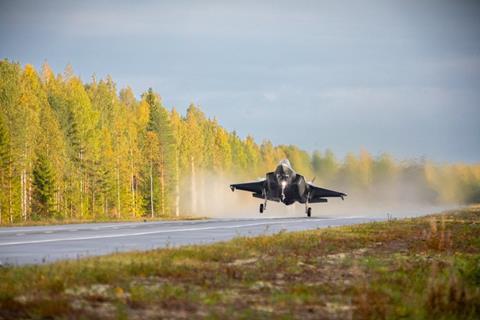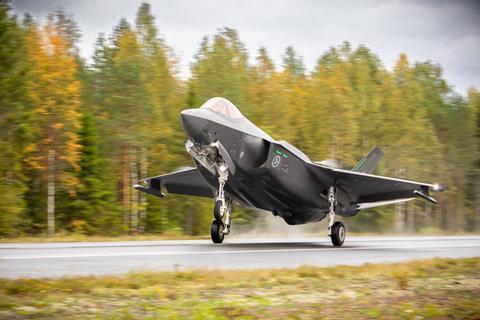The Royal Norwegian Air Force (RNoAF) successfully landed two Lockheed Martin F-35A stealth fighters on a rural highway in Finland, before executing a quick turnaround and take off.
The accomplishment marked the first time that the conventional take-off variant of the fifth-generation F-35 fighter “operated from a motorway”, according to Lockheed. Norway says the exercises were meant to validate the distributed model of air combat operations pioneered by Nordic countries.
The RNoAF revealed the milestone shortly after it occurred on 21 September, saying the capability to use motorways alongside other small airfields, rather than relying on large air bases known to enemy forces, will increase the survivability of its fleet during war.
“This demonstrates our ability to execute a concept of dispersal,” says RNoAF chief Major General Rolf Folland, who was present at the highway site near Tervo, Finland.
Folland calls the motorway landing a milestone “not only for the Norwegian Air Force, but also for the Nordic countries, and for NATO”.
Lockheed calls the event “anything but ordinary”.
The USA accomplished a similar feat with the short take-off and vertical landing F-35B variant in California in August. That type is only operated by a small number of services, according to Cirium data, including the US Marine Corps, UK Royal Air Force and Italian navy.
The F-35A conventional variant is far more common, particularly among European operators who would be on the front lines of conflicts involving NATO.
Nordic countries Finland, Sweden and Norway have long evaluated their combat aircraft for such highway landings, considering the dispersed operations model to be a strategic deterrent.
The US Air Force (USAF) has begun adapting the idea, which the service calls Agile Combat Employment, or ACE, for its own forces.
USAF commandos in May successfully landed several aircraft types on a rural highway in Wyoming, including a Lockheed MC-130 special operations transport, a General Atomics Aeronautical Systems MQ-9 Reaper unmanned air vehicle and two Fairchild Republic A-10 attack jets.
The ACE approach is viewed as an answer to the proliferation of highly-accurate, long-range guided missiles that can strike major air bases in large numbers, destroying parked aircraft and damaging runways.
“The aim of the concept is to make it more challenging for an enemy to take out our aircraft when on ground,” says Folland.
During the recent highway evaluation in Finland, Norway says two RNoAF F-35As landed around 16:00h local time, following aerial exercise with Finnish Boeing F/A-18C Hornet fighters.
Immediately after landing, ground personnel executed a so-called “hot pit refueling” – topping off the F-35s with the engines running – before the jets re-launched from the roadway tarmac.
Norway’s top military officer General Eirik Kristoffersen says the exercise shows the Nordic countries along NATO’s eastern flank “can operate together as one coordinated force”.
Finland formally entered the Euro-Atlantic military alliance in April. Sweden requested to become a full member of the bloc at the same time as neighbouring Finland, but Stockholm’s accession has thus far been prevented by Turkey.
Unanimous approval from existing NATO member states is required for any new entrance into the mutual defence alliance.
Both Finland and Sweden have operated closely with NATO as non-member partners for years, while maintaining officially unaligned. Russia’s invasion of Ukraine in 2022 spurred the two countries to apply for official NATO membership and the mutual defence guarantee that comes with such status.
Norwegian defence minister Bjorn Arild Gram touted the ongoing military exercises as vital to integrating Norway’s neighbours into NATO.
“With Finland’s entry into NATO and Sweden’s imminent membership, the Nordic countries have a particular responsibility for developing and coordinating NATO’s deterrence in the northern regions,” he says.
Gram notes the combine fleets of the Nordic states will soon reach 200 combat aircraft.
Norway plans to acquire 52 F-35As, according to Lockheed.
The RNoAF reached initial operational capability on its Lightning II fleet in 2019. The service currently operates 24 of the fifth-generation fighters, according to Cirium.
Finland’s F-35 programme of record covers 64 of the planned Block 4-configuration F-35As, none of which have yet been delivered. Helsinki is to receive its first F-35 in 2025, with training in the USA preceding the planned actual arrival of the jets in Finland in 2026.






























